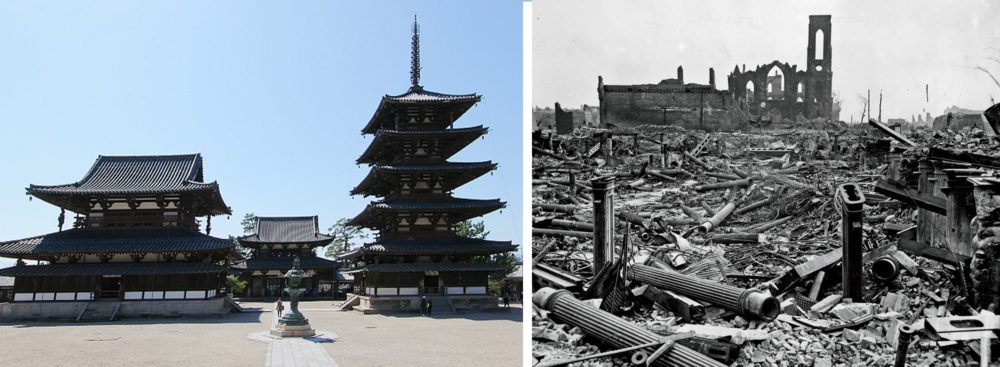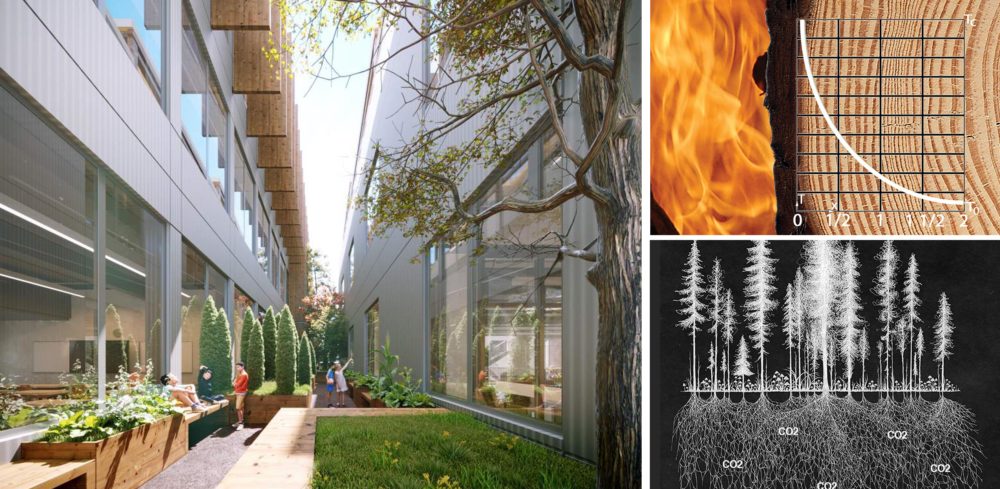Wood Structures in North America
Wood is one of the oldest building materials, dating back as far as 10,000 BCE, around the time our species began to live in permanent settlements. The oldest known surviving wood structure, the Horyuji Temple in Japan, is 1,300 years old. The Taos Pueblo in New Mexico are the oldest known buildings in the US, dating from 1000 – 1200 CE. They are constructed with large wood beams, or vigas, that were hauled down from nearby mountain forests and used to support the roof, poking through the iconic adobe walls. Smaller pieces of wood, typically pine or aspen latillas, were placed side-by-side on top of the vigas and covered with packed dirt. 1
The oldest surviving timber frame building in North America is the Fairbanks House in Massachusetts. The main roof beam has been dated to 1637 and the exterior cladding is made from oak and cedar. 2As in many parts of the world, wood was an essential material for buildings before the twentieth century. But wood had a big drawback, perhaps best exemplified by the Great Fire of Chicago in 1871, which killed approximately 300 people and destroyed over 17,000 structures, many of which were built predominantly from wood. 3

The advent of steel frames in the late 19th century reduced fire risk and allowed for much taller buildings. 4
In 1885 the 10-story Home Insurance Company Building in Chicago, the world’s first “skyscraper,” had a nearly all-metal structure consisting of cast-iron columns supporting wrought-iron beams. Throughout the twentieth century until today, this method has been used to build ever higher buildings, displacing wood as the preferred construction material.
Lately, wood is having somewhat of a renaissance. Our newest project, the Evergreen Charter School in Hempstead, New York, which uses cross-laminated timber (CLT), is a prime example. CLT, or mass timber, differs from traditional wood construction in that it is made from many compressed wood layers, making it much stronger and fire-resistant than typical lumber. Because it’s wood, it has much lower embodied carbon than its steel and concrete equivalent 5and is thus quickly becoming a popular material in contemporary construction of mid- and high-rise buildings alike.
At the same time, our office still frequently works with five and six-storey multi-family apartment buildings in New York City, which have structures that are over 100 years old and are made from a heavy timber structure. Life takes place safely every day and the buildings have accommodated changes to the layouts and services over the years. We have observed differential settlement occurring to the foundation which has resulted in sloping floors but this is easily fixed with a new floor surface.

- 1 Admin. (2023b). Pueblo Architecture of Northern New Mexico. <em>Stephen B. Chambers Architects, Inc.</em>
- 2 Anja. (n.d.). <em>Home</em>. Fairbanks House Historical Site.
- 3 <em>Tragedy in the Chicago fire and triumph in the architectural response</em>. (n.d.).
- 4 <em>STEEL</em>. (n.d.-b). http://architecture-history.or...
- 5 Liang, S., Gu, H., Bergman, R., & Kelley, S. S. (2020b). Comparative life-cycle assessment of a mass timber building and concrete alternative. <em>Wood and Fiber Science</em>, <em>52</em>(2), 217–229.